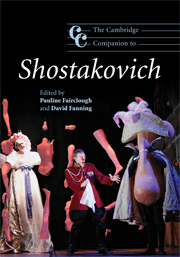Book contents
- Frontmatter
- Introduction
- PART I Instrumental works
- 1 Personal integrity and public service: the voice of the symphonist
- 2 The string quartets: in dialogue with form and tradition
- 3 Paths to the First Symphony
- 4 Shostakovich's Second Piano Sonata: a composition recital in three styles
- 5 ‘I took a simple little theme and developed it’: Shostakovich's string concertos and sonatas
- PART II Music for stage and screen
- PART III Vocal and choral works
- PART IV Performance, theory, reception
- Notes
- Select bibliography
- Index
1 - Personal integrity and public service: the voice of the symphonist
from PART I - Instrumental works
Published online by Cambridge University Press: 28 September 2011
- Frontmatter
- Introduction
- PART I Instrumental works
- 1 Personal integrity and public service: the voice of the symphonist
- 2 The string quartets: in dialogue with form and tradition
- 3 Paths to the First Symphony
- 4 Shostakovich's Second Piano Sonata: a composition recital in three styles
- 5 ‘I took a simple little theme and developed it’: Shostakovich's string concertos and sonatas
- PART II Music for stage and screen
- PART III Vocal and choral works
- PART IV Performance, theory, reception
- Notes
- Select bibliography
- Index
Summary
To the European mind, no less than fifteen symphonies from the pen of a single composer might seem excessive in the light of a tradition that has taken its bearings from the nine symphonies of Beethoven. But the revolutionary culture that nurtured Shostakovich experienced something of a rebirth of symphonic commitment, and in this connection the ideological climate of Socialist Realism (first proclaimed in 1934) was to prove a potent factor. Far from creatively inhibiting, the Beethoven canon, with its fresh post-revolutionary optimism, could be viewed as positively enabling. The Soviet symphony – a genre that Shostakovich's own Fifth Symphony served memorably to define – became for Shostakovich, as for his colleagues, a medium through which to appear to meet the sociopolitical expectations of Soviet ideology. At the same time, his symphonies, string quartets and concertos encoded a more personal vision that was to remain suspect in orthodox Soviet circles. As a captive yet independently minded artist working in a totalitarian regime, Shostakovich invented for himself a moral persona that would construct, Dostoyevskylike, a polyphonic discourse wherein, to quote Victor Terras on Bakhtin, ‘multiple individual voices, inner dialogue, parody, inter-textual echoes, irony, and ambiguity interact dialogically, independently of a controlling monologic narrative voice’.
Although not all of Shostakovich's symphonies sit comfortably within the traditional parameters of the genre, taken as a whole his symphonic oeuvre gravitates towards the four-movement sonata-cycle prototype, and embraces the several different types – instrumental/absolute, narrative/programmatic, cyclic, vocal-instrumental – that go to make up the main-stream repertoire of the genre in the post-Beethoven era. The content and form of these symphonies, as well as their social context, are linked to Shostakovich’s well-known dilemma as a Soviet composer: the conflictridden burden of responsibility he carried towards his genius, his public and, as a professional artist, the Soviet cultural bureaucracy.
- Type
- Chapter
- Information
- The Cambridge Companion to Shostakovich , pp. 7 - 37Publisher: Cambridge University PressPrint publication year: 2008
- 2
- Cited by

